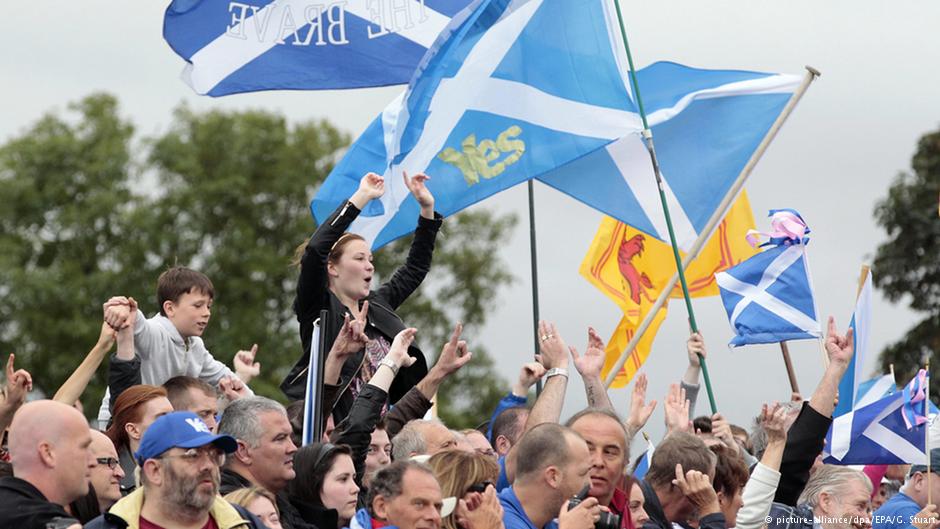It’s been quite a post-Brexit week for Scotland. First Minister Nicola Sturgeon has been pushing the pro-EU case at home and in Brussels, but there remains a long way to go, as Peter Geoghegan reports from Glasgow.
On the stone forecourt of Scotland’s modern, glass-fronted devolved parliament in Edinburgh three flags flutter in a stiff breeze: the Scottish Saltire; the red, white and blue of the United Kingdom; and the European Union’s starry standard. Whether the trio are still flying outside Holyrood once the Brexit process is finished is much less certain.
This week Scottish First Minister Nicola Sturgeon embarked on an unprecedented mission: to keep Scotland in the European Union despite the UK’s vote to leave the EU last week.
Scots backed remain by a significant margin and Sturgeon described the prospect of Scotland being taken out of the European Union against its will as a “democratic disgrace.” She has said she will “explore all options” for retaining Scotland’s EU membership – including a possible second referendum on independence.
Sturgeon’s Scottish National Party (SNP) has been in power in Edinburgh for almost a decade and holds the overwhelming majority of the Scottish seats in Westminster. But whether the Scottish first minister has the political – or public – support needed to salvage her country’s place in the EU remains to be seen.
Earlier this week, in front of a packed house at an emergency session of the Scottish parliament, Sturgeon won cross-party support for her intention to “explore all options open to Scotland to secure our relationship with the EU.” The SNP leader also announced the establishment of a council of experts to advise the Scottish Government “on the best way to achieve our EU objectives.”
Brussels or bust?
With support from Holyrood in tow, Ms Sturgeon headed straight for Brussels – but the reception in the European Union capital was more mixed.
Irish Premier Enda Kenny made an unexpected intervention at the European Council “on behalf” of the Scottish first minister. But both the French and Spanish prime ministers said that they were opposed to the EU negotiating potential membership for Scotland.
Spanish leader Mariano Rajoy said he “believes everyone is extremely against it” and that “if the UK leaves, Scotland leaves.”
Sturgeon’s meetings with the president of the European Commission, Jean-Claude Juncker, and his opposite number in the European Parliament, Martin Schulz, also failed to yield the desired results. Juncker said that while Scotland had “won the right to be heard in Brussels” he did not intend “to interfere in an inner British process.”
How Scotland might remain within the European Union and the UK – publicly stated as the preferred position of the Scottish government – is not at all clear. Earlier suggestions that Holyrood could veto the Brexit vote have been rejected, and increasingly Edinburgh civil servants are scrambling for precedents.
The grass is always greener
One idea that been mooted is the so-called reverse Greenland. Although part of Denmark, Greenland sits outside the frontiers of the EU. Some Scottish commentators have suggested that the whole of the UK could remain within the European Union but with only Scotland governed by EU legislation.
However such a compromise would be politically unworkable, says Andrew Tickell, a columnist for The Times in Scotland.
“A Greenland-inspired fudge would put four-fifths of (the UK’s) population outside the EU. For the European institutions, this would be intolerable, but it looks like rotten politics for the rest of the UK too,” he told DW. “Try selling that idea to the voters of England. The House of Commons would have a collective aneurism.”
If Scotland cannot agree on a deal to stay within the EU and the UK there could be another vote on independence. In the wake of last week’s Brexit vote, opinion polls have shown a clear majority of Scots now in favor of leaving the United Kingdom.
But the road to a second independence referendum is far from clear.
Holyrood does not have the legal powers to call another referendum. Under the terms that established the Scottish parliament in 1998, the three centuries of union between England and Scotland is a matter reserved to Westminster. Given the extraordinary circumstances it could be politically impossible for London to block a second Scottish vote but any decision could be open to challenge in the court.
There is also no guarantee that nationalists would win a referendum next time around. Support for leaving the UK is still below the 60 percent threshold identified by Sturgeon as the trigger for a second vote.
Meanwhile, the problems that dogged the pro-independence campaign in 2014 – particularly around currency and the economy – remain unresolved.
“I don’t anyone has had the time to sit down and do the hard thinking to resolve these issues. They will need to be resolved second time around,” Alistair Clark, senior lecturer in politics at Newcastle University, told DW.
Voter fatigue
Another issue is voter fatigue. Scots have gone to the polls three times in less than two years, and there is limited appetite for another vote among the electorate.
“Please god, not another referendum,” Glaswegian pensioner Majorie Sweeney told DW when asked about the prospect of a vote on independence, echoing a widespread feeling among Scots.
Another Scottish referendum in the short term is unlikely. It could be months before Article 50 of the Lisbon Treaty is triggered, sealing the UK’s exit from Europe. In the interim, Sturgeon can be expected continue to lobby for a Scottish solution while testing the waters for a second referendum.
“We really are in uncharted territory,” says Alistair Clark. “There is a lot of it left to play out. Nothing is going to happen quickly.”




